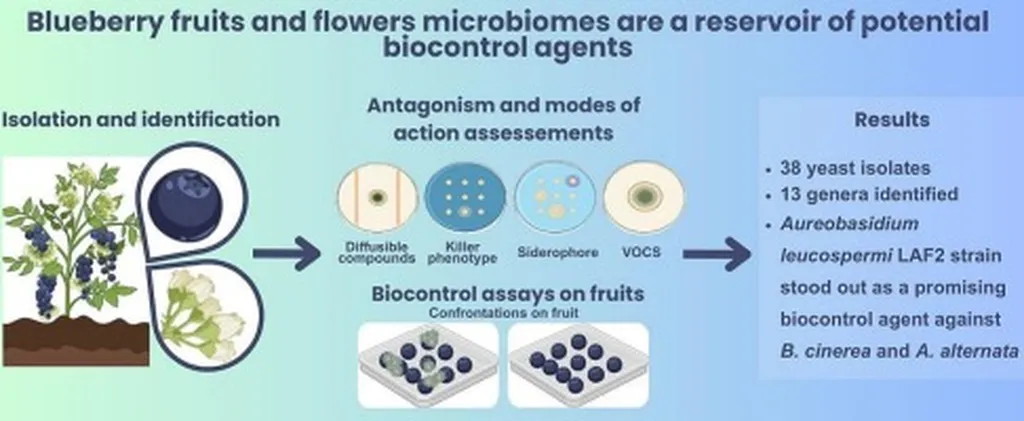In the heart of Argentina’s blueberry fields, a silent battle rages between the prized fruits and two formidable fungal foes: Botrytis cinerea and Alternaria alternata. These pathogens have long plagued blueberry production, causing significant economic losses. But a glimmer of hope has emerged from an unlikely source: the very fruits and flowers themselves. A recent study published in the journal *Biological Control* has unveiled the potential of native blueberry-derived yeasts as biocontrol agents, offering a sustainable alternative to synthetic fungicides.
Florencia Isabel Chacón, a researcher at the Planta Piloto de Procesos Industriales Microbiológicos (Pilot Plant of Industrial Microbiological Processes) in San Miguel de Tucumán, Argentina, led the study. Her team explored the cultivable portion of the epiphytic yeast community on blueberry fruits and flowers, seeking yeasts capable of protecting the plants from these major phytopathogens.
The researchers isolated and identified various yeast strains, including members of the genera Rhodotorula, Hanseniaspora, and Aureobasidium, among others. Among these, one strain stood out: Aureobasidium leucospermi LAF2. This strain demonstrated remarkable biocontrol efficiency, protecting blueberry fruits against Botrytis cinerea by 58.33% and Alternaria alternata by 67.78% at 25°C.
“The results were quite promising,” Chacón said. “We found that A. leucospermi LAF2 not only inhibited the growth of these pathogens but also produced hydroxamate-type siderophores and volatile organic compounds (VOCs) that could inhibit B. cinerea growth by 48.19%.”
The study’s findings suggest that the epiphytic microbial communities on fruits and flowers could be a reservoir of potential biological control agents. This research could pave the way for developing sustainable and effective biocontrol strategies, reducing reliance on synthetic fungicides, and promoting more environmentally friendly agricultural practices.
The commercial implications for the blueberry industry are substantial. With the global demand for blueberries continuing to rise, the need for sustainable and effective disease management strategies has never been greater. The use of native yeasts as biocontrol agents could not only improve crop yields and quality but also enhance the industry’s environmental stewardship.
As Chacón and her team continue to explore the potential of these native yeasts, the future of blueberry production looks brighter. Their work, published in *Biological Control* (translated as “Biological Control”), offers a promising path forward, one that could reshape the agricultural landscape and contribute to a more sustainable future for the energy sector and beyond.
In the words of Chacón, “This is just the beginning. There’s so much more to discover and explore in the world of microbial communities and their potential applications.” The journey towards sustainable agriculture has taken a significant step forward, and the blueberry industry is poised to reap the benefits.

